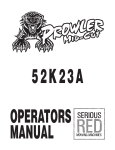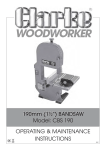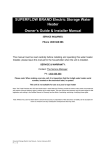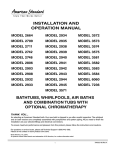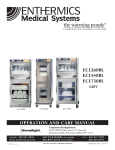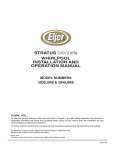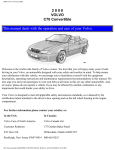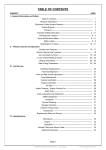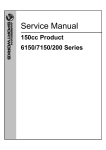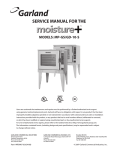Download Draper 36761 Owner`s manual
Transcript
360mm BANDSAW ■ STOCK No.36761 ■ PART No.BS355A • INSTRUCTIONS • IMPORTANT: PLEASE READ THESE INSTRUCTIONS CAREFULLY TO ENSURE THE SAFE AND EFFECTIVE USE OF THIS TOOL. 12/2000 GENERAL INFORMATION This manual has been compiled by Draper Tools and is an integrated part of the power tool equipment, which should be kept with the machine. This manual describes the purpose for which this tool has been designed and contains all the necessary information to ensure its correct and safe use.We recommend that this manual is read before any operation of the machine, before performing any kind of adjustment to the machine, and prior to any maintenance tasks. By following all the general safety instructions contained in this manual, it will ensure both machine and operator safety, together with longer life of the tool itself. All photographs and drawings in this manual are supplied by Draper Tools to help illustrate the operation of the machine. Whilst every effort has been made to ensure accuracy of information contained in this manual, the Draper Tool policy of continuous improvement determines the right to make modifications without prior warning. 360mm BANDSAW ■ STOCK No.36761 CONTENTS: ■ PART No.BS355A Page No. Contents/Declaration .......................................................................................1 Specification/Guarantee...................................................................................2 Power Supply ...................................................................................................3 General Safety Instructions ..............................................................................4 Additional Safety Rules ....................................................................................5 Unpacking and Checking Contents..................................................................6 Getting to Know your Bandsaw.........................................................................7 Assembly .........................................................................................................8 Operation and Use ......................................................................................9-12 Tips on Using Your Bandsaw ......................................................................13-14 Maintenance/Optional Accessories................................................................15 DECLARATION OF CONFORMITY We Draper Tools Ltd. Hursley Road, Chandler’s Ford, Eastleigh, Hampshire. SO53 1YF. England. Declare under our sole responsibility that the product: Stock No:- 36761. Part No:- BS355A. Description:- Bandsaw. To which this declaration relates is in conformity with the following directive(s) 98/37/EC & 89/336EEC. JOHN DRAPER Managing Director 17/03/99 -1- SPECIFICATION The Draper Tools policy of continuous improvement determines the right to change specification without notice. Part No. ................................................................................................................BS355A Stock No...................................................................................................................36761 Maximum cutting height........................................................................................139mm Throat depth..........................................................................................................360mm Motor size ................................................................................................375W induction Blade Length........................................................................................................1784mm Table size ......................................................................................................400x400mm Disc size ................................................................................................................152mm Table tilt....................................................................................................................0-45° Disc table tilt ............................................................................................................0-45° Speeds (rpm) ........................................................................................3 (160, 750, 1200) Nett/Gross weight................................................................................................30/32kg Sound pressure level ........................................................................................<70db(A) ALWAYS WEAR EAR AND EYE PROTECTION GUARANTEE Draper machine tools have been carefully tested and inspected before shipment and are guaranteed to be free from defective materials and workmanship for a period of 12 months from the date of purchase except where tools are hired out when the guarantee period is ninety days from the date of purchase. Should the machine develop any fault, please return the complete tool to your nearest authorized warranty repair agent or contact Draper Tools Limited, Chandler's Ford, Eastleigh, Hampshire, SO53 1YF. England. Telephone: (023) 8026 6355. If upon inspection it is found that the fault occurring is due to defective materials or workmanship, repairs will be carried out free of charge. This guarantee does not apply to normal wear and tear, nor does it cover any damage caused by misuse, careless or unsafe handling, alterations, accident, or repairs attempted or made by any personnel other than the authorised Draper warranty repair agent. This guarantee applies in lieu of any other guarantee expressed or implied and variations of its terms are not authorised. Your Draper guarantee is not effective unless you can produce upon request a dated receipt or invoice to verify your proof of purchase within the 12 month period. Please note that this guarantee is an additional benefit and does not affect your statutory rights. Draper Tools Limited -2- POWER SUPPLY CONNECTING YOUR MACHINE TO THE POWER SUPPLY: (230V) To eliminate the possibility of an electric shock your machine has been fitted with a BS approved, non rewireable moulded plug and cable which incorporates a fuse, the value of which is indicated on the pin face of the plug. Should the fuse need to be replaced an approved BS1362 fuse must be used of the same rating, marked thus . The fuse cover is detachable, never use the plug with the cover omitted. If a replacement fuse cover is required, ensure it is of the same colour as that visible on the pin face of the plug (i.e. red). Fuse covers are available from your Draper Tools stockist. If the fitted plug is not suitable, it should be cut off and destroyed. *The end of the cable should now be suitably prepared and the correct type of plug fitted. See below. *WARNING: A plug with bare flexible wires exposed is hazardous if engaged in a live power socket outlet. WARNING: THIS APPLIANCE MUST BE EARTHED. Green & Yellow - Earth, Blue - Neutral, Brown - Live. As these colours may not correspond with the coloured markings identifying the terminals in your plug, proceed as follows: The wire which is coloured green & yellow must be connected to the terminal in the plug which is marked with the letter ‘E’ or by the earth symbol or coloured green or green and yellow. The wire which is coloured blue must be connected to the terminal which is marked with the letter ‘N’ or coloured black or blue. The wire which is coloured brown must be connected to the terminal which is marked with the letter ‘L’ or coloured red or brown. N.B. Three phase machines must be connected by a qualified electrician. Ampere rating (on Name plate) Extension cable length 7.5M 15M 22.5M 30M 45M 3 6 10 13 0.75 0.75 0.75 0.75 0.75 0.75 0.75 0.75 0.75 1.25 1.0 1.0 1.0 1.25 1.5 1.25 1.5 1.5 1.5 2.5 -3- GENERAL SAFETY INSTRUCTIONS FOR POWER TOOLS WARNING Please read the following instructions carefully, failure to do so could lead to serious personal injury. IMPORTANT Draper Tools Limited recommends that this machine should not be modified or used for any application other than that for which it was designed. If you are unsure of its relative applications do not hesitate to contact us in writing and we will advise you. 1. 2. 3. 4. 5. 6. 7. 8. 9. 10. 11. 12. 13. 14. KNOW YOUR POWER TOOL Read and understand the owner's manual and labels affixed to the tool. Learn its application and limitations as well as the specific potential hazards peculiar to this tool. KEEP WORK AREA CLEAN Cluttered areas and benches invite accidents. Floors must not be slippery due to oil or sawdust. AVOID DANGEROUS ENVIRONMENTS Do not use power tools in damp or wet locations, or expose them to rain. Keep work area well lit. Provide adequate space surrounding the work area. Do not use in environments with a potentially explosive atmosphere. KEEP CHILDREN AWAY All visitors should be kept a safe distance from work area. STORED TOOLS When not being used, all tools should be stored in a dry, locked cupboard or out of the reach of children. WEAR PROPER CLOTHING Do not wear loose clothing, neckties or jewellery (rings, wristwatches) to catch in moving parts. NONSLIP footwear is recommended.Wear protective hair covering to contain long hair. Roll long sleeves above the elbow. USE SAFETY GOGGLES (Head Protection) Wear CE approved safety goggles at all times. Normal spectacles only have impact resistant lenses, they are NOT safety glasses. Also, use face or dust mask if application is dusty and ear protectors (plugs or muffs) during extended periods of operation. NOISE LEVELS Some types of machines may have high noise levels when working. In such cases ear protection must be worn. VIBRATION LEVELS Hand held power tools produce different vibration levels. You should always refer to the specifications and relevant Health and Safety guide. DUST EXTRACTION If your tool is fitted with a dust extraction fitting, always ensure that it is connected and being used with a dust extractor.Vacuum cleaners can be used if suitable for the material being extracted. PROTECT YOURSELF FROM ELECTRIC SHOCK When working with power tools, avoid contact with any earthed items (e.g. pipes, radiators, hobs and refrigerators, etc.). If you are using a power tool in extreme conditions (e.g. high humidity or generating metal dust), always use an RCD (residual current device) at the power socket. STAY ALERT Always watch what you are doing and use common sense. Do not operate a power tool when you are tired or under the influence of alcohol or drugs. WHEN WORKING OUT OF DOORS Only use extension leads designed for that purpose. ACCESS TO MAINS SOCKET If a stationary machine is fitted with a moulded plug and cable, the machine should not be positioned so that access to the mains socket is restricted. 15. 16. 17. 18. 19. 20. 21. 22. 23. 24. 25. 26. 27. 28. 29. 30. DISCONNECT POWER TO THE TOOL When not in use, before servicing and when changing accessories such as cutters, etc. AVOID ACCIDENTAL STARTING Make sure the switch is in the OFF position before plugging the machine into the power supply. NEVER LEAVE MACHINE RUNNING UNATTENDED Turn power off. Do not leave machine until it comes to a complete stop. DO NOT ABUSE THE CORD Never carry the tool by the power cable or pull it from the socket. Keep the power cable away from heat, oil and sharp edges. NEVER STAND ON TOOL Serious injury could occur if the tool is tipped or if the cutting tool is accidentally contacted. Do not store materials above or near the tool, so that it is necessary to stand on the tool to reach them. CHECK DAMAGED PARTS Check for damage to parts, breakage of parts, mountings and any other conditions that may affect its operation. A guard or other part that is damaged should be properly repaired or replaced. KEEP GUARDS IN PLACE And in working order. MAINTAIN TOOLS WITH CARE Keep tools sharp and clean for the best and safest performance. Follow instructions for lubricating and changing accessories. All extension cables must be checked at regular intervals and replaced if damaged. Always keep the hand grips on the tool clean, dry and free of oil and grease. USE RECOMMENDED ACCESSORIES Consult the owners manual for recommended accessories. Follow the instructions that accompany the accessories. The use of improper accessories may cause hazards. REMOVE ADJUSTING KEYS AND WRENCHES Form a habit of checking to see that keys and adjusting wrenches are removed from the tool before turning it on. SECURE WORK Use clamps or a vice to hold work. This frees both hands to operate the tool. DO NOT OVERREACH Keep proper footing and balance at all times. USE RIGHT TOOL Do not force the tool or attachment to do a job for which it was not designed. DO NOT FORCE TOOL It will do the job better and safer at the rate for which it was designed. DIRECTION OF FEED Feed work into a blade or cutter against the direction of rotation of the blade or cutter only. WHEN DRILLING OR SCREWING INTO WALLS Always make sure there is no danger of hitting any hidden power cables, water or gas pipes in the wall. IMPORTANT NOTE Residual Risk. Although the safety instructions and operating manuals for our tools contain extensive instructions on safe working with power tools, every power tool involves a certain residual risk which can not be completely excluded by safety mechanisms. Power tools must therefore always be operated with caution ! -4- ADDITIONAL SAFETY RULES FOR BANDSAWS/DISCS AND STRIP SANDERS 14. Permanently fix your bandsaw to a bench before performing cutting operations. (See ‘Fastening to a Workbench’, page 9). 1. Lower the blade guard to within approximately 3mm above the material being cut. 2. Always keep hands and fingers away from the saw blade, especially when coming to the end of a cut. 15. Use in a well ventilated area and dust extraction to minimise airborne dust. 3. Use a push stick or piece of scrap wood to do the pushing and guiding when sawing small pieces which would otherwise require the fingers to be close to the saw. 16. Before freeing any jammed material turn switch off, disconnect from power supply and wait for all moving parts to stop. 17. Before starting to cut, watch the saw while it runs. If it makes an unfamiliar noise or vibrates excessively, stop immediately. Turn the saw off and disconnect from the power supply. Do not attempt to use the saw until the problem has been rectified. 4. Switch the machine off and let the blade come to a stop before removing scrap pieces from the table. 6. Make all adjustments and set ups with the power off and plug removed from the power supply, such as tilting the table, adjusting the saw blade guards and blade guides. 18. Repair or servicing required on this product should be made only by a qualified person.When servicing use only identical replacement parts. 7. Disconnect the machine before adjusting the blade tension and the blade tracking. 8. The cover housing must be in place and securely fastened before performing any operation. 19. Do not use saw bands which are damaged or deformed. 20. Replace table insert when worn. 9. Securely lock all adjustable parts so they cannot loosen. This will prevent distraction from the operation. 21. When cutting round timber use a suitable device to prevent twisting of the workpiece. 10. When sawing curves, make relief cuts to allow removal of scrap material. This will help prevent undue twisting or binding of the saw blade. The relief cuts are made before starting the curved saw cut. 22. When bevel cutting with the table inclined, place the guide on the lower part of the table . 23. Connect bandsaws to a dust collecting device when operating. 11. Hold material firmly and feed into the blade at a moderate speed. 24. Do not operate the machine when the door or guard protecting the band is not closed. 12. Be sure to use the correct blade size and type for the application. 13. Do not saw any material that does not have a flat surface, unless a suitable support is used. -5- UNPACKING AND CHECKING CONTENTS WARNING For your own safety, do not connect the plug to the power supply until all the assembly steps are completed and you have read and understood the safety and operational instructions. Carefully unpack the bandsaw and all the loose items from the carton. The photograph below, illustrates the bandsaw and all the loose parts. Refer to Fig.1. Check that all the parts are present. If any parts are damaged or are missing, please call the Draper Helpline on (023) 8049 4344. Fig.1. -6- GETTING TO KNOW YOUR BANDSAW Fig.2. Fig.2. 1. No Volt switch 2. Drive wheel & sanding disc 3. Sanding guard (not shown) 4. Sanding table 5. Sanding table lock knob 6. Motor pulley 7. Idler wheel 8. Lower back bearing 9. Lower blade guides 10. Upper blade guides 11. Upper back bearing 12. 13. 14. 15. 16. 17. 18. 19. 20. 21. 22. Blade guard Tracking wheel Tension bolt Height adjustment lock knob Tracking bolt Motor Work table Tilt indicator Table lock knob Power on/off switch lock Sawdust extraction outlet -7- ASSEMBLY Your bandsaw is supplied assembled except for the work and sanding table. To assemble the worktable to the bandsaw: 1. Remove the table lock knob $, spring % and spring support bush & from the table support at the rear of the bandsaw (Fig.3). 2. Remove the hex socket head table alignment screw and clamp from the underside of the worktable. Standing at the rear of the of the bandsaw with the slot of the table facing the machine, fix the table so that the blade passes through the table slot, and the table support rod ' goes through the curved slot in the tilt indicator (Fig.4). 3. Replace the spring support bush & with the large flange end facing towards the tilt indicator. 4. Push the spring % over the spring support bush &. 5. Screw the lock knob $ onto the table support (Fig.5, 5A). Fig.3. & % $ Fig.4. ' Fig.5. Fig.5A. FASTENING TO WORKBENCH (fixing bolts not supplied) Your bandsaw should be bolted to a solidly built workbench. Mounting holes are provided in the base of the machine. Large flat washers should be used between the bolt heads and the base to fasten more securely and prevent any damage to the bandsaw. Tighten snugly but do not overtighten SPEEDS Your bandsaw is equipped with pulley steps for three speeds - adequate for all normal working requirements. Always use low speed for cutting nonferrous metals. Medium and high speeds are used for other materials, depending on blade type. -8- % & % & $ OPERATION & USE ON/OFF SWITCH When key is in the off/locked position, it will prevent unauthorized operation of the bandsaw (Fig.6). Fig.6. Fig.7. The bandsaw is fitted with a no volt switch. In the event of a power supply failure the bandsaw will have to be manually re-started (Fig.7). CHANGING SPEEDS 1. Turn the main power switch off and disconnect from the power supply. 2. Remove the front cover. 3. Refer to Fig.8. and check which pulley steps to use for the desired speed and adjust as required. 4. Change the belt on the motor pulley or drive wheel will allow you to move it from a larger diameter step to a smaller step. 5. Replace the front cover. Fig.8. DRIVE WHEEL -9- MOTOR PULLEY OPERATION & USE CHANGING BLADES 1. Turn the main power switch off and disconnect from the power supply. 2. Remove front cover. 3. Remove the upper blade guard (, loosen locking screw ) and adjust the upper support bearing * away from the blade (Fig.9). 4. Loosen the upper and lower blade guide locking screws + and move the blade guides away from the blade (Fig.10). 5. Loosen locking screw , and adjust the lower support bearing - away from the blade (Fig.10). 6. Using the hex key supplied . turn the blade tensioning bolt / clockwise to decrease the blade tension (Fig.11). 7. Remove the old blade. Slip the new blade over the three wheels, placing the blade as close as possible to the centre of the wheels (make sure the teeth face the table). 8. Turn the tensioning bolt / anticlockwise until the blade is tensioned. 9. Rotate the idler wheel by hand until the blade centres correctly on all three wheels. If the blade does not track correctly, adjust the tracking bolt 0 while rotating the idler wheel until it does so (Fig.12). 10. Adjust the top * and bottom blade support bearings so they are just touching the rear of the blade and lock in place. 11. Adjust the blade guides so there is a gap of approx. 1mm between each guide and the blade and lock in place. 12. Reassemble the blade guard (. 13. Replace the front cover. - 10 - Fig.9. ) ( * Fig.10. + , Fig.11. - . / Fig.12. 0 OPERATION & USE MITRE GUIDE Most cross cut work, especially with small pieces of material are more easily controlled with the aid of the mitre guide 3. The guide is graduated to 45˚ for assistance in cutting both left and right hand angles. Fig.13. RIP FENCE True straight line rip cutting is best done by guiding the work against the rip fence 2. The fence can also be used for cutting off exact widths. Fig.14. WARNING: The supporting surface where the band saw is mounted, should be examined carefully after mounting to ensure that there is no movement during use. If any tipping or walking is noted, secure the workbench or supporting surface before operating bandsaw. CIRCLE CUTTING ATTACHMENT The circle cutting attachment 4 mounts on the arm of the upper guide block 5. Accurate circles can be cut out with a radius of 50mm - 200mm Make the first cut to the perimeter of the circle freehand before setting the pivot pin 6 of the attachment into the work. The pivot pin must be aligned exactly to the right of the blade tips. If the pivot is too far back, the blade will run outside the desired circumference. If too far forward, the blade will run inside. USING YOUR BANDSAW AS A POWER BELT SANDER Remove the blade and fit a sanding belt 7 as explained in CHANGING BLADES (page10). However, make sure that the blade support bearings and the blade guides, both upper and lower, are well clear of the abrasive sanding belt. Two sanding stops are available, one straight and one slightly curved. Screw the stop into the threaded hole in the worktable near the table insert with the hex screws provided with the sanding kit. Adjust the stop so that the belt just rests against it. - 11 - Fig.13. 3 Fig.14. 2 Fig.15 5 4 6 Fig.16. 7 OPERATION & USE Remove the saw blade as explained in CHANGING BLADES (page11). Remove the sanding disc guard from the front cover. Mount the support rod 8 of the sanding table through the hole under the sanding disc. Tighten the table lock knob at the left hand side of the bandsaw until the table is held firmly. The sanding table is slotted for use with the mitre guide supplied with your bandsaw. The sanding table can be tilted to 45° for bevel and compound mitre sanding. For best results, set the bandsaw at high speed. (See CHANGING SPEEDS page 9). Replacement sandpaper discs are available from the Draper Stockist (see optional accessories page15). They can be obtained in four grits and are self-adhesive so that no glue is required to fix them to the aluminium disc. - 12 - 8 Fig.17. TIPS ON USING YOUR BANDSAW WORKTABLE The worktable is a 400x400mm aluminium die-casting. It supports the material being cut and is grooved to accept a mitre guide and rip fence. The rip fence can be attached to both the front and rear of the table. The table can be tilted to every angle from 0-45° making possible a large variety of bevel and compound angle cuts. The tilt indicator beneath the table shows the angle setting. The centre of the worktable is protected with a table insert, easily and economically replaced if damaged. TIPS ABOUT BANDSAW BLADES The size of a band saw blade is denoted by width, length and thickness. This bandsaw uses blades which are 1785mm long, 0.4mm thick and from 6 - 13mm wide. The number of teeth per inch and the type of tooth determines the application of the blade. A wide choice of blades are available for different applications. There is no general purpose bandsaw blade which is suitable for all operations. Narrow blades will cut to a tighter radius than wider blades. Finer toothed blades will make a smoother, but slower, cut than coarse blades. As a wide blade has more contact with the blade guides, it is easier to cut a true straight line than with a narrow blade. This is particularly important in rip-cutting when the blade has a natural tendency to follow the grain of the wood. Blades for cutting hard materials have more teeth per inch. For cutting thin hard materials, the number of teeth per inch needs to be much greater than for the thicker material. If the distance between each tooth is greater than the thickness of the material being cut, the teeth may grab in the work and break off. The following chart shows recommended blade widths for cutting curves. SAWDUST EXTRACTION OUTLET It is recommended that this is used. It can be connected to a vacuum cleaner which will provide fast and efficient removal of sawdust from your machine. The vacuum cleaner may be used continuously or intermittently depending upon your requirements. INTERNAL CONSTRUCTION The three wheel construction of this bandsaw makes possible the 360mm throat and 140mm depth of cut capacity within a compact bench mounted unit. The drive wheel is powered by a belt from the motor pulley. Both the drive wheel and the idler wheel are fixed in position and do not require adjustment. The tracking wheel can be adjusted to centre the blade on the three wheels when running. Because of the selftensioning feature of this bandsaw, frequent tracking adjustments are not required. Each wheel is fitted with a rubber tyre to prevent the blade from slipping and to protect the sharp edges of the blade teeth. These tyres are easily replaced if they become torn or worn. Width of Blade Min. Radius of Curve 6mm 10mm 13mm 25mm Since it is nearly impossible to resharpen blades, discard all blunt blades. Never attempt to use a bent or cracked blade. - 13 - TIPS ON USING YOUR BANDSAW the table it will help support the work against slip. The width of cut indicator shows the distance between the blade and the rip fence at the table surface. For all cutting operations the upper blade guard should be adjusted to just clear the work being cut (approx. 3mm or 1⁄8"). Not only does this provide the best operator safety, but it also brings the blade guides closer to the work giving more accurate results and easier control. Use both hands to feed the workpiece into the blade. The work must be held flat on the table at all times to prevent binding of the blade. Use a steady even pressure just sufficient to keep the blade cutting at full speed. Always use a rip fence or mitre guide where possible to eliminate any sideways slip of the work. This is most important when the table is tilted to an angle. Always plan work ahead. The tradesmans’ rule is “measure twice, cut once”. It is best to finish a cut in one continuous operation, but frequently backtracking will be necessary. Turn off the motor and allow the blade to come to a complete stop before backing the blade out of the cut. Remember that the blade removes material during the cut. This gap created by the blade is called the kerf and must be allowed for when cutting to exact sizes. Plan your cut so that the kerf is to the scrap side of the line you wish to cut. If necessary, allow a little more for finish sanding. CROSS CUTTING This term refers to the cutting of timber across the grain. This type of cut can also be made freehand or with the aid of the mitre guide. The mitre guide can be adjusted to a 45˚ angle to assist during mitre cuts, and with compound mitre cuts. Make sure the work is held firmly against the table and against the face of the mitre guide. Be careful to keep your fingers away from the blade, particularly at the end of the cut. FREEHAND SAWING The ease with which many different and varied shapes can be cut is one of the most important features of the bandsaw. Select a blade suitable for cutting the smallest radius in the work you have planned. When freehand cutting always feed the work slowly so that the blade can follow the line you wish to saw. Make sure not to drag the work off line forcing the blade sideways, or twisting it. In many cases, it is helpful to rough cut about 6mm away from the line in difficult curves and corners. In the case of very sharp curves which may be too tight for the blade, make relief cuts onto the face of the curve so that these scraps will fall as the final radius is sawn. RIP SAWING This term refers to the cutting of timber with the grain rather than across the grain.You can rip wood freehand to a previously drawn line, but best results are obtained by using the rip fence. If the table is level, set the rip fence to the left hand side of the blade. This allows you to use your right hand to hold the work firmly against the fence. The width of cut indicator on the front of the worktable shows the distance between the blade and the right hand edge of the timber. When cutting a bevel rip, with the table tilted at any angle up to 45˚, set the rip fence to the right hand side of the blade if the width of the workpiece allows it. With the fence on the downhill side of CUTTING NONFERROUS METALS Metal must only be cut at the lowest speed on your bandsaw. Never attempt metal sawing at wood cutting speed your blade will burn up very quickly. Other than speed and correct blade selection, metal sawing is much the same as wood sawing, however, the rate at which you feed the work into the blade must be reduced to only as fast as the blade can cut. Also, metals do not have the ‘give’ that timber has, so the work must be held very firmly to prevent twisting or misalignment of the blade while feeding. - 14 - MAINTENANCE CHANGING TYRES Eventually the rubber tyres on the bandsaw wheels will wear due to the constant contact of the sharp teeth of the blade. Remove the blade, lift the edge of the tyre with a small screwdriver and the tyre can be worked off the wheel easily.We recommend that the three tyres be changed at the same time. (See Spare Parts Listing/Drawing). Refit blade BLADE GUIDES Blade guides should be inspected regularly for wear or chipping.When replacing guides replace all guides at the same time, both upper and lower. (See Spare Parts Listing/Drawing). BEARINGS All bearings used in the construction of your bandsaw and its motor are sealed and lubricated for life. CLEAN OUT Accumulated dust and chips should be removed from inside the bandsaw frequently. Disconnect from the power supply, remove the front cover and use a brush or vacuum cleaner. At the end of every work session clean sawdust away from the motor vents. BLADE BRUSH Ensure that you check on a regular basis that the brush is in full contact with the bandsaw blade and wheel. This will help to keep the tyres on the wheel clean and assist with the quick and smooth run down of the bandsaw blade. NOTE: Bandsaw blade should stop within 10 seconds of the machine being switched off as per original set up. OPTIONAL ACCESSORIES Bandsaw Blades Stock No. Part No. 25766 BB1785 25767 BB1785 25768 BB1785 25769 BB1785 25770 BB1785 Blade width 1/4" 3/8" 1/2" 1/4" 1/2" Teeth 6 skip 6 skip 6 skip 6 skip 6 skip Grade 60 80 100 120 *Assorted Quantity 5 pack 5 pack 5 pack 5 pack 5 pack Grade 60, 80, 120 Quantity 3 pack Blade length Application 1785mm wood/plastic 1785mm wood/plastic 1785mm wood/plastic 1785mm metal 1785mm wood/metal Sanding Discs Stock No. 25971 25972 25973 25974 25975 Part No. SD6 SD6 SD6 SD6 SD6 *1x60, 2x80, 1x100, 1x120 Sanding Belt Stock No. 25988 Part No. SB1785 - 15 - Quantity 1 pack 1 pack 1 pack 1 pack 1 pack NOTES - 16 - NOTES - 17 - NOTES - 18 - DRAPER TOOLS LIMITED, Hursley Road, Chandler's Ford, Eastleigh, Hants. SO53 1YF. U.K. Helpline: (023) 8049 4344. Sales Desk: (023) 8049 4333. General Enquiries: (023) 8026 6355. Fax: (023) 8026 0784. http://www.draper.co.uk e-mail: [email protected] YOUR DRAPER STOCKIST ©Published by Draper Tools Ltd. No part of this publication may be reproduced, stored in a retrieval system or transmitted in any form or by any means, electronic, mechanical photocopying, recording or otherwise without prior permission in writing from Draper Tools Ltd.




















